-
-
-
Ichiyo-Seminar
Corrie van der Meer-Fischer & Jeanne Rauwenhoff -
-
Event in
Ephesos Museum Wien -
“Spring awaiting summer“
I.I. in the Weltmuseum Wien -
WUK:
“From tradition to modernity“ -
Friendship through Flowers
Ikebana International Vienna | Austria
IKEBANA INTERNATIONAL
Ikebana International is a worldwide organization founded in Tokyo in 1956 and has today over 6.000 members in 138 chapters in 50 countries all over the world. The aim of Ikebana International is to promote cultural dialogue between Japan and other countries.
The administration of Ikebana International is in the hands of dedicated volunteers and Ikebana Schools, whose diversity is linked to the common root of inspiration, style, philosophy and history of floral art.
Regional conferences are held all over the world. Members can attend these as well as the World Congress, which takes place every five years in Japan. Membership is open to everyone interested in the art of flower arranging, regardless of one´s previous knowledge. A regular magazine informs members about new trends and activities of Ikebana International and connects the members of this global organization under the motto:
„Friendship through Flowers”
Ikebana International Vienna News
We look forward to special exhibitions in spring 2020. These are organized together with Dr. Noriko Brandl from the Austrian-Japanese Society and the World Museum Vienna Friends!
IKEBANA-artists thrilled colleagues and the audience in Vienna
Ikebana International Vienna invites international well-known masters to magnificent events. In 2019, on the occasion of the 150-year-anniversary of diplomatic relations between Japan and Austria, Eikou Sumura thrilled hundreds of visitors in the World Museum Vienna. Unforgettable are the numerous workshops performed by Atsuko Bersma and Corrie van den Meer-Fischer.
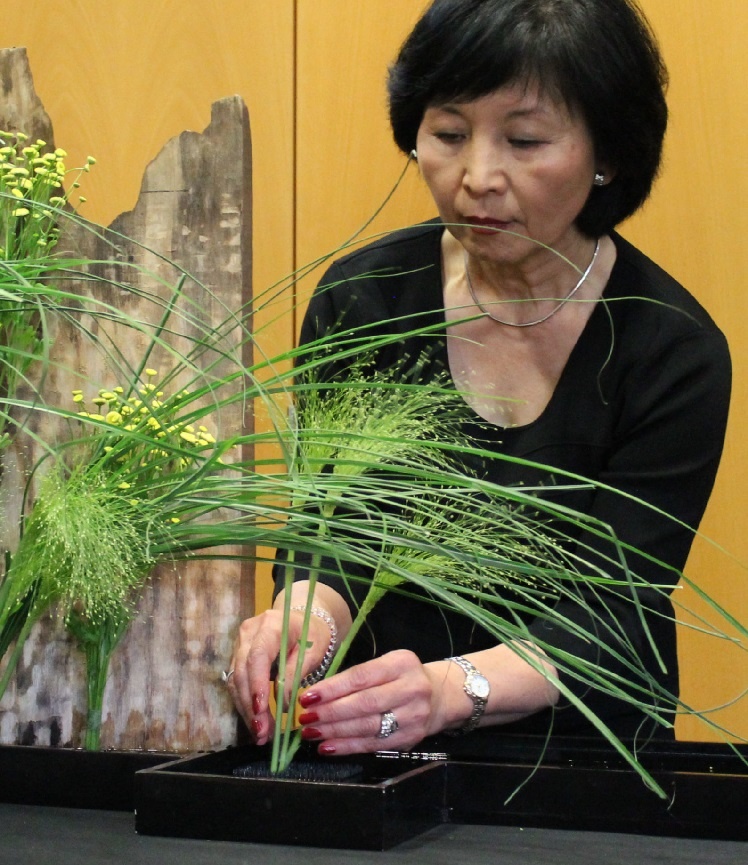
Atsuko BERSMA
was born in Yokohama and started taking ikebana lessons at the age of 11. Since 1970, she has combined her studies with teaching Sogetsu ikebana in various places she has lived around the world. She received the prestigious Sogetsu Overseas Award. 2019 she was awarded The Order of the Rising Sun,Gold and Silver Rays for her contribution to spreading out Japanese Culture.
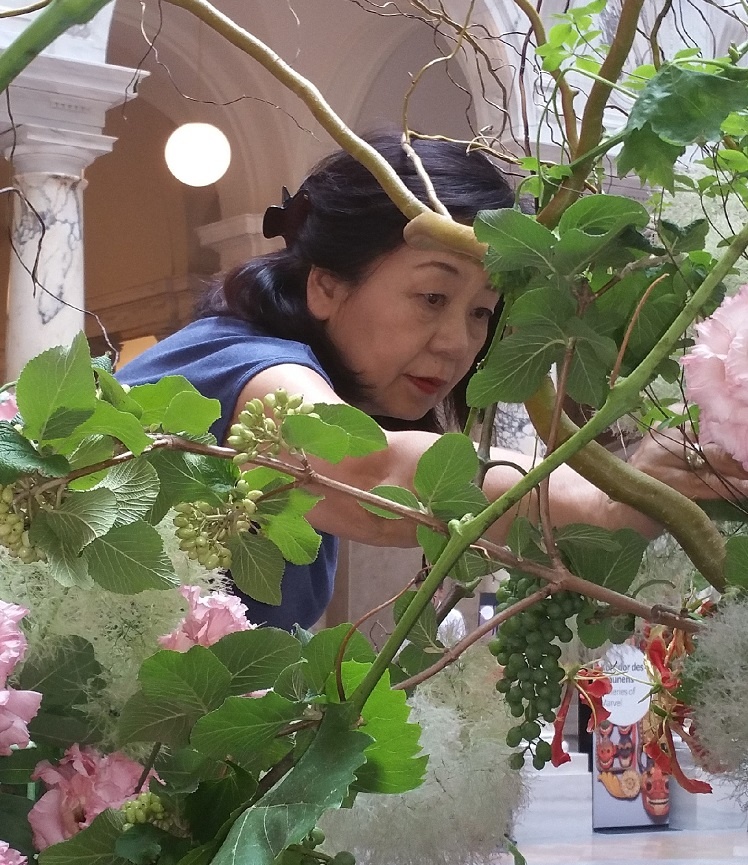
Eikou SUMURA
Sogetsu Master-Instructor Sumura Eikou is a unique ikebana artist, renowed for her use of a diverse range of natural materials beyond the usual fresh flowers and plants. She has made it her lifework to introduce people around the globe to the Japanese art of ikebana, and has made extensive trips on behalf of the Ministry of Foreign Affairs of Japan to countries all over the world.
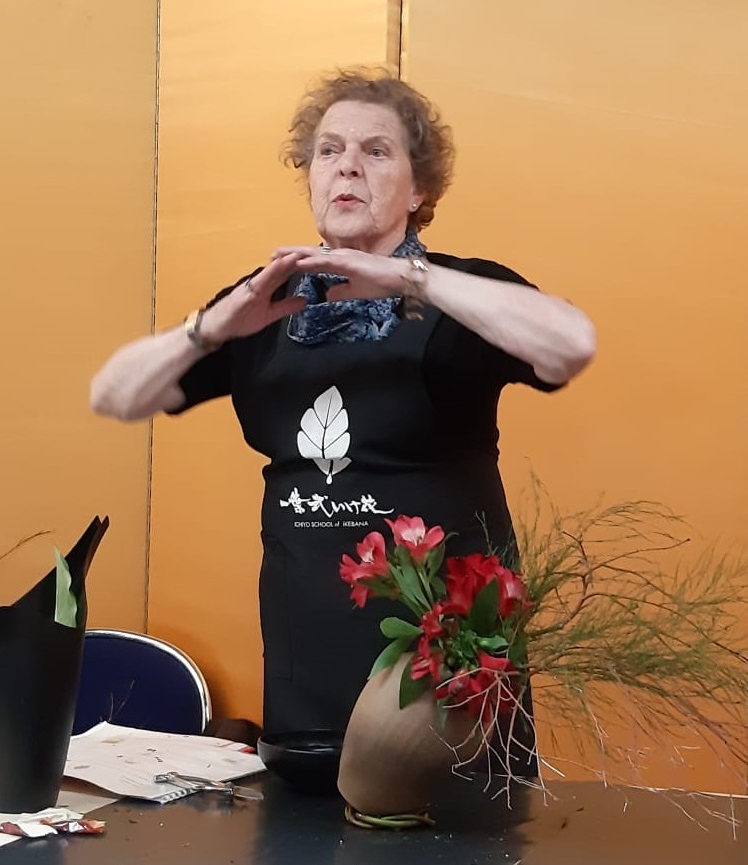
Corrie van der MEER-FISCHER
was born in Switzerland and lives in the Netherlands. She is Appointed-Master of Ichiyo, President of the „Dutch Ikebana Association“, „I.I. Chapter 215“ and „Ichiyo Chapter the Netherlands“. In 2016 she received The Order of the Rising Sun, Gold and Silver Rays in recognition of her significant contribution to introducing the Japanese culture and promoting the understanding of Japan.
IKEBANA 生け花 – „animation of the flower”
Ikebana is the classical Japanese art of flower-arrangement. Its aim is to emphasize the beauty of flowers, leaves, and branches, therebye finding mental concentration, tranquility, and harmony. The plants show out of themselves the vital, swift change of the blooming of buds. Change can be observed in the arrangement or it becomes itself theme like the atmosphere in autumn.
The arrangement is inner nature evoking the atmosphere of a season, the character of a landscape, and the feelings of the artist. It is not a matter of plenty but of the beauty of each single flower. Concentrating on the little, essential here and now is the mental-meditative aspect of ikebana. Furthermore, the variation of ikebana itself reflects, as other forms of art do, the variations of the way of thinking and of the life-style of our time.
The 3 pillars of activity of Ikebana International Vienna
Promotion of the art
Ikebana International Vienna cultivates the Japanese art of flower-arrangement in course of monthly meetings. Since its foundation a remarkable archive has been established consisting of a library, collections of photographs, journals, Ikebana International magazines, lists of annual events in Austria etc.
Events
Ikebana International Vienna is considered to be a platform for the presentation of the art of ikebana. Therefore, events are organized regularily – in most cases in cooperation with known Ikebana-masters at overwhelming locations. International exchange of experience and national events are essential constituents of this organization.
Seminars
With pleasure Ikebana International Vienna wants to disseminate the original Japanese art of flower-arrangement in Austria. Thus, we promote Ikebana-seminars and workshops to people who take an interest in it, and further Ikebana demonstrations for a large audience. We are pursuing the idea of passing on knowledge and practice to the next generation.
ORIGIN AND AIM OF IKEBANA
The history of ikebana is not considered to be a course of evolution from a religious tradition to art. Rather, origin and aim of ikebana, the “vigorous life of the flower” is a subtle claim to aesthetics with metaphysical profundity of living being.
Probably it was the fascination that flowers were not only subject of passion for beauty penetrating the aristocratic court´s life in Kyoto, headquarter of the Emperor. Flowers were also considered to be part of poetic and artistic awareness. It is said that the Emperor himself and the aristocratic court “fixed” (sasu) flowers in vases. At court flower competitions had been organized since the 12th century.
Nowadays historical research does not trace the origin of ikebana exclusively to the “offertory flowers” (kuge) in Buddhist monasteries. Its focus lies on the pre-sixteenth century Muromachi period (named after a district in Kyoto; residence of the Ashikaga shōgunate 1336-1573). As indication of the starting point of the ikebana tradition in this period can be considered the Buddhist rikka style 立華, i.e. the formally correct “standing flower” arrangement in vases. The emphasis shifted from the sensual perception of color and perfume of the petals alone to the entire flower with stem and leaves.
The methods of stabilization flowers in a vase and the efforts to “stand upright” (tateru) led to the beginning of the flower arrangement tatehana 立華. Experience had shown that bundles of rice straw stuffed into the vase were very efficient. Hence, by the sixteenth century the gorgeous rikka style developed being arranged after strict rules by Buddhist monks and shōgunal attendants, experts for arts (who were partially monastic and secular). The later were especially distinguished by their knowlegde of etiquette in the residence´s reception hall.
By the mid-fifteenth century such a monk from the “Ikenobō” hermitage received preference by the military rulers. Under the patronage of the aristocracy the Ikenobō master Senkei and his successors predominated over all other schools.
From the cultural center the imperial flower arrangement of Ikenobō were spread to the regions. Thus “Standing flowers” continued being practiced from generation to generation. The teaching of the Ikenobō tatehana was orally transferred from master to student. In the course of time the works of prominent masters were passed on as drawings with commentaries.
The Ōnin War (1467-1568) marked a socio-cultural, political break and shift of power.
In the Muromachi period the roles of host and guest were defined anew in the tea ceremony under the influence of the Zen-Buddhism, a unique encounter to experience humanity. According to the philosophical essence of „nageire” flowers, a free informal style without rules expressed the rejection of precious vases and elitist purposes, modesty instead of materialism. Later the flowers for the Zen-Buddhist tea ceremony nageire hana were named chabana.
The architectonic requirement for the development of the art of flower arrangement was the alcove wall oshi-ita in the formal reception room in domestic architecture and the tokonoma alcove in tea-houses. From the 20th century onward ikebana has been detached from the tokonoma of the traditional Japanese living room. Since the late 1950s ikebana has become an avantgarde movement. Contempory ikebana has found new spaces for its representation like stages and open sites and reflects the ideas and intention of the artist addressing to the spectator. Not only during the ikebana performance the act of arranging is more important than the finished work of art being short-lived anyway. Ikebana has been enriched over centuries with contents, aesthetic knowledge and skill being conveyed – unlike other artforms – with living nature. With/Practicing ikebana you actively bring the actual philosophy to life at this very moment in this common space.
The secret of success of spreading ikebana-schools all over the world is indeed the joy in creative assembling without limit thanks to nature´s abundance, and the merry-making experience of beauty and harmony.
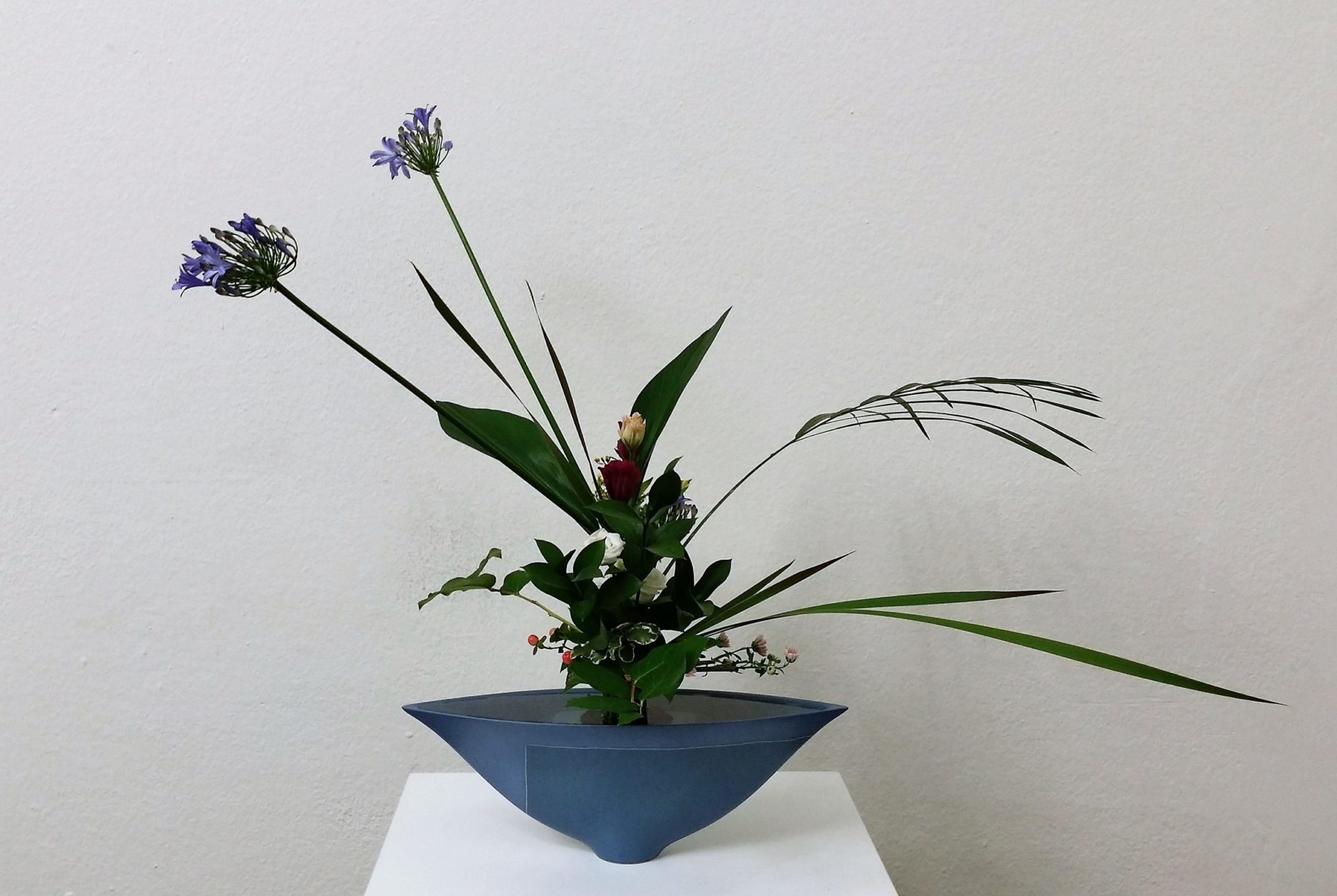
Andrea Scheberl, Rikka-style of the Ikenobo school, MQ Vienna 2019
“The all-embracing cosmos of Rikka with mountains, rivers, and valleys can also be interpreted as the body of Buddha (in the center).”
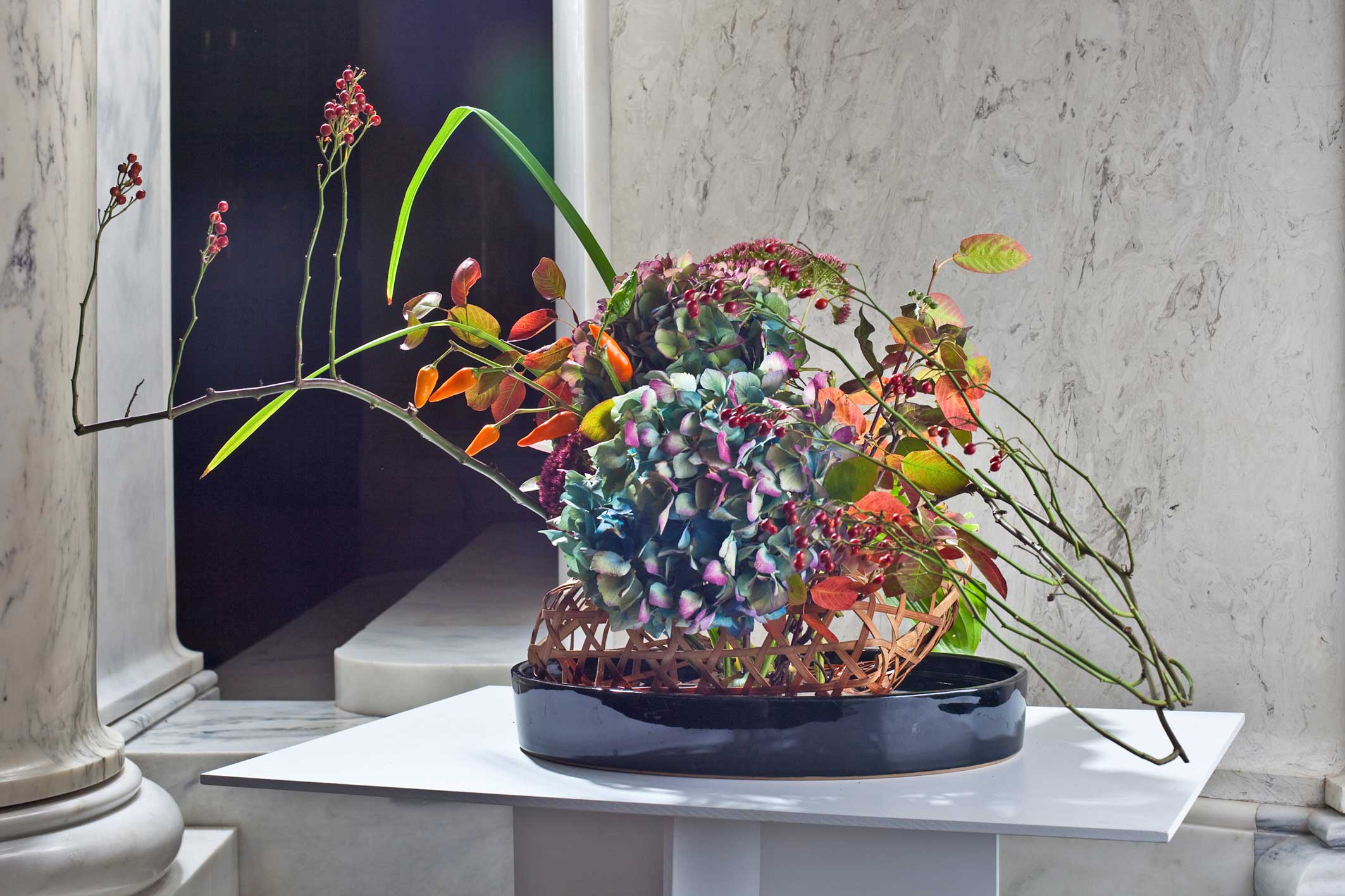
Itsuko Nakayama, Ichiyo-Schule, Weltmuseum Wien 2009
At that time the artist participating at the exhibition in Vienna was president of Ikebana International HQ.
The Four Schools of IKEBANA International
Ichiyo
一葉式いけ花
The Ichiyo School of Ikebana was founded in 1937 by brother and sister Ichiyo and Meikof/Meiko Kasuya. The head of the school Akihiro Kasuya (1983-2019) was followed by his son Naohiro. The school has pursued a new course in ikebana teaching, namely systematically structured textbooks, slides and clear composition of line, form, colour, and emptiness – all in balance of asymmetry.
Ikenobo
池坊
Ikebana has its roots in the Buddhist flower offertories. This tradition was transferred from China to Japan in the 7th century. In the mid-fifteenth century the Ikenobo School was documented for the first time and received the imperial title ‘Parent house of flower teaching.’ Having its headquarters in Kyoto the school is not only the oldest, but also the largest Japanese ikebana school.
Misho-ryu
未生流
Mishosai Ippo, founder of the Misho-School in Osaka, lived from 1761 until 1824. The emphasis of his forms of expression is the classical Kakubana style (Seika) invented by Mishosai Ippo himself. The arrangement is surrounded by a circle. A square is inscribed in this circle resulting from the connection of the four contact points of the arrangement with the circle, representing inwardly the earth and outwardly with the four angles the four seasons and the four directions.
Sogetsu
草月流
Talking about modern ikebana today, it is meant first of all the form of ikebana that has been instructed and become known all over the world by the Sogetsu-School in Tokio. The Sogetsu-School was founded by Sofu Teshigahara in 1927 in Tokio. From childhood he was instructed in the art of flower arranging by his father, an ikebana-teacher.

